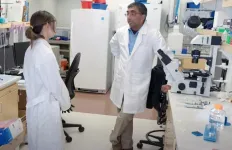(Press-News.org) A new study found that increased exposure to residential greenery may help stave off cognitive decline by an annual rate of eight months. This delay was observed more among people living in low-socioeconomic status and highly populated neighborhoods, as well as people who carry the APOE-ɛ4 gene, which is associated with an increased risk of Alzheimer’s disease.
Research has shown that about 40 percent of dementia could be prevented or delayed worldwide by addressing modifiable risk factors associated with the condition, particularly during midlife.
A new study led by a Boston University School of Public Health (BUSPH) researcher is shedding deeper insight on how one risk factor—living near greenery, such as parks and trees—during middle-age years could provide cognitive benefits later in life.
Published in the journal Environmental Health Perspectives, the study found that residing in areas with higher amounts of greenness during midlife may slow a person’s annual rate of cognitive decline by about eight months. This association was stronger among people living in neighborhoods of low socioeconomic status (SES), highly populated neighborhoods.
This association was also observed among people with the APOE-ɛ4 gene, a variant of the APOE gene that is a major risk factor for Alzheimer’s disease. APOE-ɛ4 carriers exposed to more greenery had a threefold magnitude of slower cognitive decline, compared to people without the gene, which is an important research development, as there are currently no known ways for carriers of this gene to reduce their risk of developing dementia.
Greenness exposure has previously been linked to better cognitive functioning, but this new study includes a much larger study group and longer period of observation than prior analyses. It is also the first study to explore how different environmental features may affect the relationship between greenness and cognition among carriers of the APOE-ɛ4 gene.
Considering that Alzheimer’s disease and related dementia cases may develop as many as 20 years before recognizable symptoms appear, it is critical to identify which populations are most susceptible to these conditions and the protective measures that can be implemented as early as possible in life to thwart or slow cognitive impairment.
“Our results are important because they shed light into the cognitive benefits of increasing green space exposure at a population level, particularly among vulnerable subgroups of the population, such as carriers of the APOE-ɛ4 gene,” says study lead and corresponding author Dr. Marcia Pescador Jimenez, assistant professor of epidemiology at BUSPH.
To examine the association between residential greenness and cognitive function and decline, Dr. Pescador Jimenez and colleagues from Rush Medical College, Rush Alzheimer’s Disease Center, and Harvard T.H. Chan School of Public Health utilized data from the Nurses’ Health Study (NHS), a prospective study that began in 1976 and is among the largest investigations into the risk factors for chronic diseases among US women. The team focused on 16,962 nurses aged 70 or older who were enrolled in an NHS substudy that started between 1995-2001 and lasted through 2008. The participants were assessed for cognitive function through telephone surveys, and the researchers utilized a satellite image-based metric to measure greenness levels around participants’ residential areas. They assessed greenness exposure up to nine years prior to the first cognitive test, and the total cognitive assessment included five cognitive tests administered up to four times over an average of six years.
After adjusting for age and socioeconomic factors, higher average exposure to greenness during midlife was linked to higher levels of cognitive function as well as slower cognitive decline, based on global cognition scores but not verbal memory.
Importantly, this association was stronger for participants living in low-SES and highly populated neighborhoods, suggesting that efforts to increase greenery in disadvantaged areas could help reduce socioeconomic inequities among these populations.
“Our finding for participants living in neighborhoods with lower socioeconomic status is consistent with the theory of equigenic environments, which suggests that greenness might be important to reduce socioeconomic health inequities,” Dr. Pescador Jimenez says.
The study also explored the role of mental health in the relationship between midlife greenness exposure and cognition. While previous research has suggested that limited exposure to greenery in middle age can decrease cognitive functioning by way of depression, the new data extends this connection by suggesting that greenness maybe associated with cognitive decline over time through mental health.
“The findings emphasize the importance of prioritizing the preservation and creation of green spaces, particularly in low-SES neighborhoods, as a means of promoting cognitive health later in life,” says Dr. Pescador Jimenez.
**
About Boston University School of Public Health
Founded in 1976, Boston University School of Public Health is one of the top ten ranked schools of public health in the world. It offers master's- and doctoral-level education in public health. The faculty in six departments conduct policy-changing public health research around the world, with the mission of improving the health of populations—especially the disadvantaged, underserved, and vulnerable—locally and globally.
END
Living in greener neighborhoods during midlife can slow cognitive decline
A new study found that increased exposure to residential greenery may help stave off cognitive decline by an annual rate of eight months.
2024-07-17
ELSE PRESS RELEASES FROM THIS DATE:
Research tracks 66 million years of mammalian diversity
2024-07-17
When trying to understand the present, it's helpful to look to history. New research from the University of Nebraska–Lincoln examined the fossil record going back 66 million years and tracked changes to mammalian ecosystems and species diversity on the North American continent.
The study, led by Alex Shupinski, who earned her doctorate in May, and co-authored by Kate Lyons, associate professor in the School of Biological Sciences, provides a large-scale view of how species diversity changed over the first 65 million years of the Cenozoic era — up until the arrival of humans — ...
RegeneratOR Test Bed welcomes Cytoink to accelerate biomedical innovations
2024-07-17
Winston-Salem, North Carolina — July 17, 2024 — The RegeneratOR Test Bed, located in Innovation Quarter, announces the inclusion of Cytoink into its pioneering ecosystem dedicated to advancing biomedical research and development. Cytoink brings cutting-edge biomaterials manufacturing, with over 100 custom formulations, and bioprinting expertise that merges biofunctionality with high-throughput production. Cytoink specializes in the biofabrication of in vitro 3D tissue phantoms, extrusion-based and light-based (DLP/VAM) bioinks, and integrated perfusion microfluidics bioreactors. Additionally, Cytoink provides bespoke biomaterial solutions ...
Jeffrey Spraggins named director of Vanderbilt University Mass Spectrometry Research Center
2024-07-17
Jeffrey Spraggins, associate professor of cell and developmental biology, biochemistry, and chemistry, has been named director of the Mass Spectrometry Research Center. He succeeds Richard Caprioli, Stanford Moore Chair in Biochemistry, who established the MSRC in 1998 and who is retiring this summer.
Spraggins is a leading scientist in spatial biology and imaging mass spectrometry—an untargeted molecular imaging approach that enables molecular mapping at cellular resolution—a technology originated by Caprioli. Spraggins’ research lies at the intersection of technology development, data science, and biomedical research. His research group ...
Duke-NUS finding advances quest to slow ageing
2024-07-17
An ageing population will bring colossal health, social, and economic challenges over the coming decades[1]. As people live longer, staving off the physical decline and frailty that come with age has become a holy grail, with effective interventions projected to unlock significant societal and economic benefits. Estimates suggest that a slowdown in ageing that increases life expectancy by one year alone is worth US$38 trillion.[2]
In a discovery published in Nature, a team of scientists from Duke-NUS Medical School in Singapore may have found a key to slow ageing.
The ...
Logged forests can still have ecological value – if not pushed too far
2024-07-17
Researchers have analysed data from 127 studies to reveal ‘thresholds’ for when logged rainforests lose the ability to sustain themselves.
The results could widen the scope of which forests are considered ‘worth’ conserving, but also show how much logging degrades forests beyond the point of no return.
The first-of-its-kind study, led by researchers from the Department of Life Sciences at Imperial College London with collaborators from around the world, is published today in ...
Exoplanet caught in ‘hairpin turn’ signals how high-mass gas giants form
2024-07-17
UNIVERSITY PARK, Pa. — Astronomers have discovered a planet that has the most oblong orbit ever found among transiting planets. The exoplanet’s extreme circuit — which looks closer to a cucumber than a circle — follows one of the most drastically stretched-out orbits of all known exoplanets, planets that orbit stars outside our solar system. It is also orbiting its star backwards, lending insight into the mystery of how close-in massive gas planets, known as hot Jupiters, form, stabilize and evolve over time.
The research, led by Penn State scientists, was published today (July 17) in ...
Switching off inflammatory protein leads to longer, healthier lifespans in mice
2024-07-17
Scientists at the Medical Research Council Laboratory of Medical Science and Imperial College London have discovered that ‘switching off’ a protein called IL-11 can significantly increase the healthy lifespan of mice by almost 25%.
The scientists, working with colleagues at Duke-NUS Medical School in Singapore, tested the effects of IL-11 by creating mice that had the gene producing IL-11 (interleukin 11) deleted. This extended the lives of the mice by over 20% on average.
They also treated 75-week-old mice – equivalent to the age of about 55 years in humans – with an ...
New gene therapy for muscular dystrophy offers hope
2024-07-17
A new gene therapy treatment for Duchenne muscular dystrophy shows promise of not only arresting the decline of the muscles of those affected by this inherited genetic disease, but perhaps, in the future, repairing those muscles.
The UW Medicine-led research focuses on delivering a series of protein packets inside shuttle vectors to replace the defective DMD gene within the muscles. The added genetic code will then start producing dystrophin, the protein lacking in patients with muscular dystrophy.
Currently, there is no cure for the disease ...
Scientists bridge the 'valley of death' for carbon capture technologies
2024-07-17
A major obstacle for net zero technologies in combatting climate change is bridging the gap between fundamental research and its application in the real world.
This gap, sometimes referred to as ‘the valley of death’, is common in the field of carbon capture, where novel materials are used to remove carbon dioxide from flue gasses produced by industrial processes. This prevents carbon from entering the atmosphere, helping to mitigate the effects of climate change.
Chemists have proposed and ...
Genome recording makes living cells their own historians
2024-07-17
Genomes can now be entrusted to store information about a variety of transient biological events inside of living cells, as they happen, like a flight recorder collecting data from an aircraft.
“Our method, which goes by the acronym ENGRAM, aims to turn cells into their own historians,” said Dr. Jay Shendure, a professor of genome sciences at the University of Washington School of Medicine and scientific director of the Brotman Baty Institute for Precision Medicine. Shendure led the effort, together with Wei Chen, a former graduate student, and Junhong Choi, a former postdoctoral fellow. Junhong ...
LAST 30 PRESS RELEASES:
Geometry shapes life
A CRISPR screen reveals many previously unrecognized genes required for brain development and a new neurodevelopmental disorder
Hot flush treatment has anti-breast cancer activity, study finds
Securing AI systems against growing cybersecurity threats
Longest observation of an active solar region
Why nail-biting, procrastination and other self-sabotaging behaviors are rooted in survival instincts
Regional variations in mechanical properties of porcine leptomeninges
Artificial empathy in therapy and healthcare: advancements in interpersonal interaction technologies
Why some brains switch gears more efficiently than others
UVA’s Jundong Li wins ICDM’S 2025 Tao Li Award for data mining, machine learning
UVA’s low-power, high-performance computer power player Mircea Stan earns National Academy of Inventors fellowship
Not playing by the rules: USU researcher explores filamentous algae dynamics in rivers
Do our body clocks influence our risk of dementia?
Anthropologists offer new evidence of bipedalism in long-debated fossil discovery
Safer receipt paper from wood
Dosage-sensitive genes suggest no whole-genome duplications in ancestral angiosperm
First ancient human herpesvirus genomes document their deep history with humans
Why Some Bacteria Survive Antibiotics and How to Stop Them - New study reveals that bacteria can survive antibiotic treatment through two fundamentally different “shutdown modes”
UCLA study links scar healing to dangerous placenta condition
CHANGE-seq-BE finds off-target changes in the genome from base editors
The Journal of Nuclear Medicine Ahead-of-Print Tip Sheet: January 2, 2026
Delayed or absent first dose of measles, mumps, and rubella vaccination
Trends in US preterm birth rates by household income and race and ethnicity
Study identifies potential biomarker linked to progression and brain inflammation in multiple sclerosis
Many mothers in Norway do not show up for postnatal check-ups
Researchers want to find out why quick clay is so unstable
Superradiant spins show teamwork at the quantum scale
Cleveland Clinic Research links tumor bacteria to immunotherapy resistance in head and neck cancer
First Editorial of 2026: Resisting AI slop
Joint ground- and space-based observations reveal Saturn-mass rogue planet
[Press-News.org] Living in greener neighborhoods during midlife can slow cognitive declineA new study found that increased exposure to residential greenery may help stave off cognitive decline by an annual rate of eight months.









